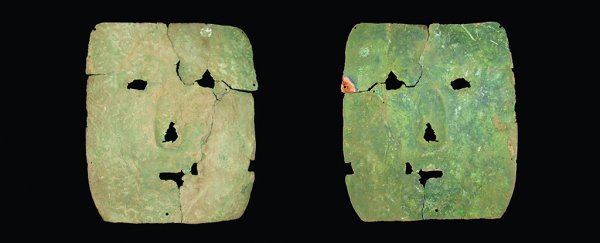A square-shaped copper mask dug up in north-west Argentina has been dated to around 3,000 years ago – and it could radically change our thinking on when people in that area began working with metal.
Most experts assume metallurgy – the study of the physical and chemical properties of metal – in South America was first developed in Peru, but the copper mask was found hundreds of kilometres away down the Andes mountains, and is from an even earlier time than similar artefacts uncovered in Peru.
As the archaeologists from the University of Buenos Aires in Argentina point out, the arrival of sophisticated metallurgy is a major technological leap in ancient historical timelines, so getting the facts pinned down is important.
"This mask is the oldest intentionally shaped copper object recovered from the Andes, with an associated radiocarbon date that suggests that metalworking technology did indeed originate in more than one region of the Andes," the team explains.
The mask, measuring 7 inches high and 6 inches wide (18 cm x 15 cm), was first discovered in 2005 by villagers, but has only just been dated. Archaeologists found 14 skeletons near the mask, suggesting it was part of a funeral ritual.
As you can see from the picture at the top of the page, the mask has nine small holes, hinting that it was tied on and leaving gaps for the eyes, nose, and mouth.
That's backed up by the green tinge on some of the bones, which could be from copper carbonate runoff from this mask and any others that were used.
The bones have been dated to between 1414 and 1010 BC, and if the mask was buried at the same time, metalworkers in Argentina were busy hammering away at complex designs much earlier than previously thought.
The location is also close by the archaeological site of Bordo Marcial, where a busy community was thought to live almost 2,000 years ago. The funeral burial appears to come from a whole millennium before that.
According to the experts, the mask would've been made using a repetitive technique where the copper was heated up and then hammered when cold. It's made from pure copper, probably mined from the Hualfin Valley around 70 kilometres (43 miles) away.
What makes it such an exciting find for archaeologists is that it's shaped into a recognisable 3D form and perforated with holes – suggesting a higher level of skill compared with other artefacts from the same era found in South America.
If this part of Argentina and the Andes was indeed one of the areas where metallurgy started to develop, it's going to give historians a lot to think about.
Copper crafting of this type quickly leads to societies developing bronze (made from copper, arsenic, and tin) – a development so important it has a whole age named after it.
That in turn leads to improved weapons, which is always an important stepping stone for any ancient civilisation.
The findings have been published in Antiquity.
